New perk! Get after it with local recommendations just for you. Discover nearby events, routes out your door, and hidden gems when you sign up for the Local Running Drop.
Emelie Forsberg, the unstoppable mountain ultrarunner from Sweden who runs most days with a flower in her hair and everyday with a contagious smile, is publishing her first book, Sky Runner, in the U.S. August 7th. Trail Runner got a sneak peek at her prose and chose the following chapter, “Freedom,” to excerpt, shared below.
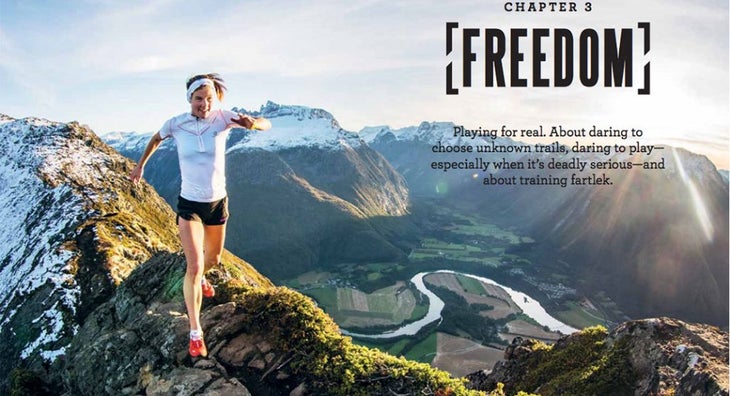
At the High Coast where I grew up, nature is wild. The forests are old and playful, with big trees, hanging lichen, and a chaotic ground layer where you can barely see where you’re treading if you dare to go outside the trail. Pebbled beaches expand with small and big rocks alike, and I play a game where I have to find the fastest way across. Smooth cliffs throw themselves towards the sea, and the sandy beaches feel eternal.
Let’s leave the trail
A good friend and I are out running at home in the southern part of the High Coast. She is there for the first time and although the pebbled beaches, the mighty cliffs, the deep forests, and Slåttdalsskrevan are well known to me, I see them as if for the first time.
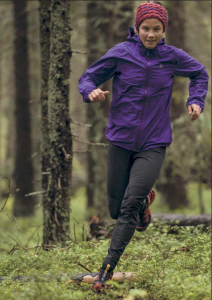
We are running along a path, sometimes talking, sometimes focusing on the running, letting our thoughts wander off—just how it is when you’re out for several hours. On our way back, we see a beautiful little mountain, on which the bare cliff forms a higher plateau. We just have to go there. This means that we are going to be out for much longer than we planned, but to stay on our trail and miss this adventure is just impossible. We leave the trail and make our way into the forest. Moss covers the entire ground layer, and the terrain is immediately wilder than along the trail, requiring our full concentration to place our feet. Pitter patter, we run side-by-side. Sometimes my friend is faster, sometimes I choose a better route. We are focused now. And eventually the hill that we saw from a distance starts.
By curiosity and desire
It is exciting to leave the beaten track, and particularly to change the planned route on pure impulse. To reach the summit is a fantastic feeling. We did it! We made our way here because it looked so exciting and beautiful. Not because we had to or not because we planned to. It’s fantastic, although it is nothing other than a detour from a path. We gave in to our curiosity and followed our desires and gained a whole new experience. We did not follow the trail; we gave in to our desire to discover.
It is typical of me to get lured away by my curiosity. It’s what drives me: daring to give in to something that is not always planned beforehand, not always following the path ahead. Either I find a new, beautiful way, or if the terrain is too difficult, I just turn around and follow my own tracks back to the path.
The most important thing is to try. Sometimes when running, it’s necessary to follow your thoughts and new ideas. Only those who do something wholeheartedly dare to let go, to leave the well-known and follow their impulses. This is how to get new perspectives and new experiences. This is so much more rewarding.
Not taking the shortest way
Sometimes I worry that I will lose my sense of playfulness, that I will lose it somewhere on the road to becoming the best version of myself as a runner and ski alpinist. I reassure myself by recalling some of my many playful memories, for example at Grand Teton National Park in the United States.
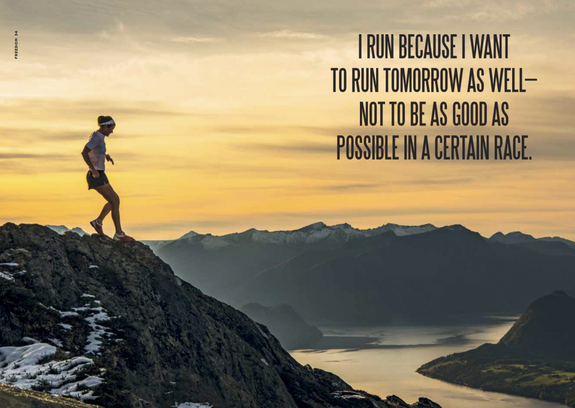
Kilian (my partner in crime) and I were going for a run. We had looked at the map and seen a mountain a bit further away, but without any trail leading all the way to it; the trail ended at a big lake. On the other side, the mountain rose over the water. We decided to run off-trail through the forest. That was easier said than done. We were engulfed in big, jungle-like trees and bushes. The 2.5 mile approach took us more than three hours. But wow, it was so awesome! We had managed to come to Mount Moran, a mountain that few visitors have seen. The climb to the summit was fast. Curiosity and relief at running without having to jump over or under bushy branches made it easy, like a game.
On our way back we decided to swim. We rolled our cellphones in our t-shirts and tied them around our heads. Neither of us can brag about any impressive swimming skills. Kilian might even have doggy-paddled. We laughed until we choked. Our bundles became heavy, and it was strenuous with them atop our heads, but we calmly continued our swim. A mile of swimming felt almost as long as the entanglement in the jungle.
If ever I hesitate to deviate from what I have planned, memories like this make me leave the planned road in the end.
I run because I want to run tomorrow as well—not to be as good as possible in a certain race.
Taking the game seriously
I believe there is room for playfulness in most peoples’ lives. As an elite athlete, I live for my own goals and work to get better, maybe even become the best. Therefore, I need to nurse my playfulness even more.
To me, playfulness is to be focused, wanting to perform at my very best, and to allow myself to live in a bubble, completely without distance from my sport. It is so real. And it is not only real, it is reality.
Paradoxically, playfulness to me is also to realize that not everything is deadly important, to keep a distance from things—from myself and from my training and racing, which is also my work—to see it all like a game. There and then the game is the only thing that matters; I do not think about the other reality at all, and that it is not even important in the long run.
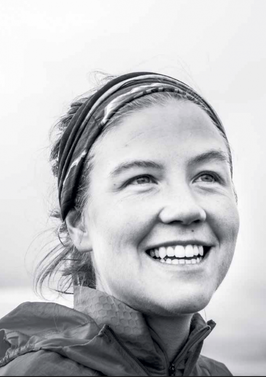
Playfulness is something beautiful and very serious. That was always my approach to running: a simple, curious, and playful approach to the run. But I have still given my running one hundred percent, without thinking of things around me. If I manage to stay playful in what I do, then it feels like I have succeeded. Without a playful approach to running, I would not be where I am today. I would not love running as much as I do. I like to sometimes run a small distance as fast as possible just for the fun of it, because it looks so nice. Or to take that little extra section just because of the excitement of it, or because of the view I think I will see when I get there.
If I were to focus on accomplishment only, to plan every training session in detail, to run every mile in a certain time, then I would not be successful in my training. My training simply has to be joyful, something I want to return to, not something I time to exactly one hour and just want to complete so I can wait for the next training session.
Some years ago, I felt that what I was doing was somehow not serious, just because I appreciated and individualized every training session. I felt that it would be more “real” if I meticulously followed a well-calculated plan; that somehow the freedom made it less serious. These are thoughts I had in the beginning of my career, but now I know that the freedom is more of a condition. I am open to changes in the training just to make it enjoyable.
We all have different motivations. My motivation has never been to become the greatest in my sport. My motivation has always been to appreciate my everyday life. And that always meant—especially the last few years—to maintain the freedom of my running. Only after fulfilling that, my motivation is to become the best possible version of me as an elite athlete.
Playfulness shows itself when I feel relaxed and safe, when I know what I am doing. In the summertime, running is number one, and I can play. I do my utmost, and I do it in the most enjoyable way possible, to appreciate and live to the fullest in what I do. To me, that’s playing.
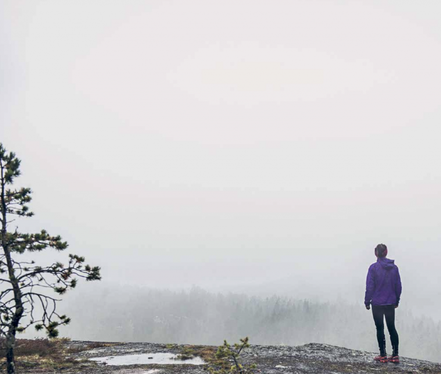
Exercises
What is your motivation? Adjust your training to your goals—and your prerequisites. And make it joyful!
I am a spontaneous person and I listen a lot to my body, so I do not plan all my training. Instead, I try to make an overall plan with a lot of flexibility in it. This means that I write down what key training sessions I would like to focus on for one particular week. The other sessions can be more impulsive. I try to do the key sessions when my body and mind are up for it, but spread out to avoid three hard training sessions in a row, of course.
Key Sessions
Draw up a plan for the key sessions you want, and allow yourself to be more impulsive with the rest.
Calculate the ultimate amount of training you need for the distances you run. We all have different requirements, and depending on what your everyday life looks like in terms of work, family, and other duties, the same amount of training can be put together differently.
Just remember that it’s during recovery that the body builds up. If your life is stressful, eight hours a week can be enough training to get in good shape for a marathon. If you have more time for training—and recovery!— you might reach 15 hours and get very good results.
Interval Training
Fartlek is a Swedish expression used to describe longer intervals, where you play with different distances and speeds. I usually simulate the altitude profile and distance of a race, and adjust my training to that. I run the race course, but in miniature. As you are able to manage more, you can gradually scale up your training course.
Fartlek 1: If I am going to run a mountain marathon with two steep climbs and a flat part at the end, I do a session with 2 x 20 minute uphill, a slow descent, and then 20 minutes on the flat. This could be done in all manner of ways, but to do it in relation to one particular race can be very rewarding.
Fartlek 2: Another good session can be 15 minutes steep uphill, 10 minutes flat, 20 minutes slight uphill, 10 minutes flat, with everything at competition speed. Hard but strengthening!
The trick is to see your training as something playful, something you want to return to, not something you have to do.
These sessions are brutal, so you don’t have to do them every week—or even every month. If you do not have access to long slopes, if might be possible to do it if you get the chance, for example, during a mountain holiday.
Goals
When I want to reach a goal, I write it down to remember it every day, to think of it every day. I soon realize if some goals are less important to me. They are always harder to work towards. When there are goals that I dream of, goals that I feel are very important, then it’s easier. So sometimes it’s worth contemplating for extra time: is this really a goal that I want to reach? Or is it rather something that is only temporarily interesting?
Emelie Forsberg, 31, is an elite Swedish ultra runner with multiple FKTs and trail race wins in Europe and the United States. She has been a member of the international Salomon ultra running team since 2012.